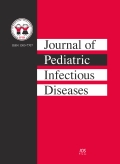Authors: Rao, Y.K. | Padhye, A. | Midha, T. | Martolia, D.S. | Kumar, A. | Gupta, A. | Mittal, P. | Papne, B.
Article Type:
Research Article
Abstract:
In India, Plasmodium falciparum is recognized as an important cause of pediatric mortality and morbidity. However, recent observations suggest there is an increasing incidence of severe cases of P. vivax, including acute renal failure. All patients in the age group 0–15 yr, presenting with fever, admitted to the Department of Pediatrics, GSVM Medical College, Kanpur, during the study period were tested for malarial parasites. Those positive for P. vivax and/or P. falciparum
…were included in the study; clinical findings and laboratory investigations were recorded and analysed. A total of 112 subjects belonging to the age group 0–15 yr were included in the study. P. vivax was detected in 70 (62.5%) and P. falciparum in 42 (37.5%). Many patients with P. vivax demonstrated signs and symptoms of severe malaria, including respiratory symptoms in 12 (17.1%), abdominal symptoms in 39 (55.7%), central nervous system symptoms in 19 (27.1%), pallor in 60 (85.7%), icterus in 9 (12.9%), edema in 15 (21.4%), hypotension in 3 (4.3%), hepatomegaly in 49 (70%) and splenomegaly in 51 (72.9%). 12.9% of P. vivax patients had acute renal failure (ARF). There is a rising incidence of P. vivax cases causing severe malaria. ARF, which was previously considered to be only due to P. falciparum, is now also caused by P. vivax. P. vivax should no longer be considered a benign species causing only non-severe malaria.
Show more
Keywords: Malaria, Plasmodium vivax, Plasmodium falciparum, clinical presentation
DOI: 10.3233/JPI-140434
Citation: Journal of Pediatric Infectious Diseases,
vol. 9, no. 4, pp. 171-176, 2014
Price: EUR 27.50





